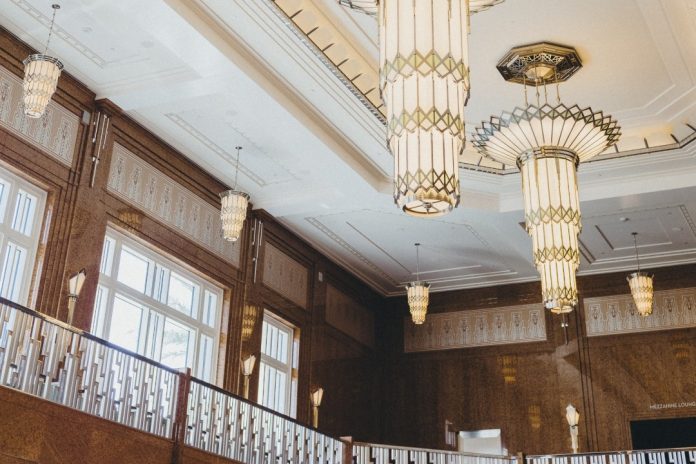The Art Deco style was popular during the late 1920s and early ’30s, with the term originating from the Exposition Internationale des Arts Decoratifs et Industriels Modernes held in Paris in 1925.
In its infancy, art deco was used solely as a decorative style of interior decoration and was very popular. It was considered functional, elegant, and ultra-modern, with an eclectic style that drew influences from Egypt, Africa, Aztec Mexico, and technology like aviation.
Art Deco is an opulent style that consists of clean lines, geometric shapes, along with the use of unusual materials, such as marble and ebony.
Other materials include rare woods, veneer, stainless steel, lacquer, aluminum, inlaid wood, shark skin, and zebra skin.
Several of the most famous and popular Art Deco designers came from Paris, France, which is where this movement began.
During the early 1900s, a man by the name of Jacques-Emile Ruhlmann ascended as one of the largest Art Deco designing industries in the world and became well known for his unusual furniture designs.
He created furniture using exotic woods, such as amboyna, violet wood, and Macassar ebony while ensuring that the pieces were elegant and comfortable.
Other famous designers include Ludwig Mies van der Rohe and Louis See and Andre Mare. Mies van der Rohe’s furniture combined a modern, machine look with a detailed hand-finished method.
The furniture was created in steel, but with a simple and elegant form. One of his most well-known pieces is the “Barcelona Chair,” which was first unveiled in 1929, and its basic form is a distorted “X” with a leather upholstered seat and back.
See and Mare formed the Compagnie des Arts Français with the purpose of making French furniture without foreign influences.
They made heavy and flamboyant pieces by using inlays and veneers to create dramatic designs, patterns, and pictures on their furniture.
Art Deco furniture is very unique, with clean lines and interesting shapes. Some sofas can be described as comfortable with barrel-shaped frames and sloped arms.
Other pieces consist of tubular steel with a chrome-plated frame upholstered in a nice fabric. You may also find club chairs in a black lacquer finish that have hand-carved details painted in vibrant colors and upholstered in a gorgeous velvet fabric.
Club chairs are very elegant and are ideal for use as conversation seating with a round table in the center. They are easy to arrange in a room because of their size.
There are other lovely chairs that have elephant arms with a rounded or mustache back. Some of the seating comes in a solid ebony frame with genuine ivory and sycamore inlays.
The ivory adorns the top edge of the wood back, along with the back area of the armrests, while the inlays are set in a linear pattern on the top front area of the arm, and the feet are a hand-carved melon style.
Some chairs come in red leather, with a flip-out leg rest, black painted metal legs, and brass sabot feet.
For a sideboard/server, you may find pieces that are a classic French buffet with a raised plynth style base, centers drawers that have brass pulls, black and white marble tops, along with a raised center area ideal for displaying an exquisite sculpture or centerpiece.
Other credenzas are created in magnificent rosewood marquetry, with stunning inlaid work and bold leg design. With Art Deco accessories, try to search for geometric decorative items that complement the exceptional geometric flair characteristic of this era.
Decorative accessories to focus on purchasing include artwork, lamps, pillows, leaded glass, chrome items, porcelain figures, statues, and sculptures.
Try to acquire pieces that match up with your overall room design in order to make it blend well. Wall art is a fabulous way to add interest and drama to your walls while complementing the rest of the items in the room.
Art deco can also be viewed as a form of abstract art that is a reminder of the turmoil in the industrial sector, along with how people began to live lavish lifestyles.
The prints have a polished look and use vivid colors. You can arrange Art Deco travel posters or advertisements in black frames to give your Art Deco decorating theme some pizzazz.
Since Art Deco was originally linked with elitism, Art Deco chandeliers have been a preferred feature of royal gathering places and churches.
Their antique appearance and large sizes match the high ceilings of such institutions. For lighting, consider an Art Deco chandelier because of the characteristic of materials that identify this style.
The materials that make up these chandeliers consist of aluminum, stainless steel, inlaid wood, and lacquer.
Furthermore, these chandeliers usually have sweeping curves in its design, with some having a sunburst motif, which is a famous example of the Art Deco chandelier design.
Finally, flooring is definitely an important element that requires special attention when decorating in this style.
Carefully choose carpeting and flooring that bring out the best qualities in this theme. Natural color flooring is a good choice because it can complement the Art Deco look in a room.
A patterned floor is more representative of this style, such as inlaid linoleums, which can be made to order.
You may also include rugs that have vibrant geometric patterns, ones that have an overall color and contrasting borders, circular area rugs with target striping, or animal skin rugs, such as zebra, polar bears, or leopards for that dramatic contrast.
About the Author
Giorgina Devereaux is the creator of FurnitureMedley.com, which features furniture website reviews and articles on home decor and furniture.

